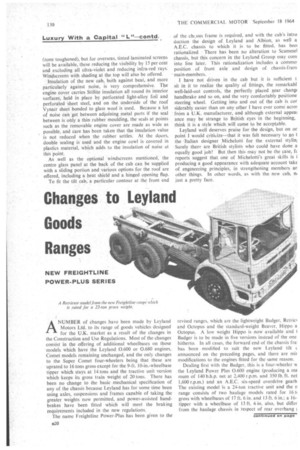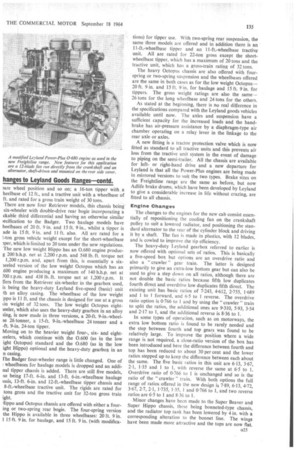Changes to Leyland Goods Ranges
Page 132

Page 137

If you've noticed an error in this article please click here to report it so we can fix it.
NEW FREIGHTLINE POWER-PLUS SERIES ANUMBER of changes have been made by Leyland Motors Ltd. to its range of goods vehicles designed for the U.K. market as a result of the changes in the Construction and Use Regulations. Most of the changes consist in the offering of additional wheelbases on those models which have the Leyland 0.600 or 0.680 engines, Comet models remaining unchanged, and the only changes to the Super Comet four-wheelers being that these are uprated to 16 tons gross except for the 9-ft. 10-in.-wheelbase tipper which stays at 14 tons and the tractive unit version which keeps its gross train weight of 20 tons. There has been no change to the basic mechanical specification of any of the chassis because Leyland has for some time been using axles, suspensions and frames capable of taking the greater weights now permitted, and power-assisted handbrakes have been fitted which will meet the braking requirements included in the new regulations.
The name Freightline Power-Plus has been given to the revised ranges, which are the lightweight Badger. Retrie) and Octopus and the standard-weight Beaver, Hippo a Octopus. A low weight Hippo is now available and I Badger is to be made in five versions instead of the one hitherto, In all cases, the forward end of the chassis frai has been modified to suit the new Leyland tilt c announced on the preceding pages, and there are mit modifications to the engines fitted for the same reason.
Dealing first with the Badger, this is a four-wheeler w the Leyland Power Plus 0.600 engine (producing a ma mum of 140 b.h.p. net at 2,400 r.p.m. and 350 lb. ft. net 1,600 r.p.m.) and an A.E.C. six-speed overdrive gearb The existing model is a 24-ton tractive unit and the n range consists of two haulage models rated for 161' gross with wheelbases of 17 ft. 6 in. and 13 ft. 6 in.; a 16tipper with a wheelbase of 13 ft. 6 in. also, but differ from the haulage chassis in respect of rear overhang t
hanges to Leyland Goods Ranges—contd.
are wheel position and so on; a 16-ton tipper with a heelbase of 12 ft., and a tractive unit with a wheelbase of ft. and rated for a gross train weight of 30 tons.
There are now four Retriever models, this chassis being six-wheeler with double-drive rear bogie incorporating a ckable third differential and having an otherwise similar lecification to the Badger. Two haulage models have heelbases of 20 ft. 9 in. and 15 ft. 9 in., whilst a tipper is ade in 15 ft. 9 in. and lift, also. All are rated for a '.-ton gross vehicle weight except for the short-wheelbase )per, which is limited to 20 tons under the new regulations. The new low weight Hippo has an 0.680 engine producg 200 b.h.p. net at 2,200 r.p.m. and 548 lb. ft. torque net 1,200 r.p.m. and, apart from this, is essentially a sixleeled version of the low weight Octopus which has an .600 engine producing a maximum of 140 b.h.p. net at 700 r.p.m. and 438 lb. ft. torque net at 1,200 r.p.m. It ffers from the Retriever six-wheeler in the gearbox used, is being the heavy-duty Leyland five-speed (basic) unit th an alloy casing. The wheelbase of the low weight ppo is 11 ft. and the chassis is designed for use at a gross in weight of 32 tons. The low weight Octopus eightteeter, which also uses the heavy-duty gearbox in an alloy sing, is now made in three versions, a 20-ft. 9-in.-wheelse 26 tonner, a 15-ft. 9-in.-wheelbase 24 tonner and a -ft. 9-in, 24-ton tipper.
Moving on to the heavier weight four-, sixand eightteeters, which continue with the 0.600 (as in the low ight Octopus) standard and the 0.680 (as in the low ight Hippo) optional and the heavy-duty gearbox in an n casing.
The Badger four-wheeler range is little changed. One of : wheelbases for haulage models is dropped and an addinal tipper chassis is added. There are still five models, se being 17-ft. 6-in. and 13-ft. 6-in.-wheelbase haulage issis, 13-ft. 6-in. and 12-ft.-wheelbase tipper chassis and 8-ft.-wheelbase tractive unit. The rigids are rated for tons gross and the tractive unit for 32-ton gross train ight.
-lippo and Octopus chassis are offered with either a fouring or two-spring rear bogie. The four-spring version the Hippo is available in three wheelbases: 20 ft. 9 in. 115 ft. 9 in. for haulage, and 15 ft. 9 in. (with modifica tions) for tipper use. With two-spring rear suspension, the same three models are offered and in addition there is an 11-ft.-wheelbase tipper and an l 1-ft.-wheelbase tractive unit. All are rated for 22-ton gross except the shortwheelbase tipper, which has a maximum of 20 tons and the tractive unit, which has a gross-train rating of 32 tons.
The heavy Octopus chassis are also offered with fourspring or two-spring suspension and the wheelbases offered are the same in both cases as for the low weight Octopus20 ft. 9 in. and 15 ft. 9 in. for haulage and 15 ft. 9 in. for tippers. The gross weight ratings are also the same26 tons for the long wheelbase and 24 tons for the others.
As stated at the beginning, there is no real difference in the specifications compared with the Leyland goods vehicles available until now. The axles and suspension have a sufficient capacity for the increased loads and the handbrake has air-pressure assistance by a diaphragm-type air chamber operating on a relay lever in the linkage to the rear axle or axles.
A new fitting is a tractor protection valve which is now fitted as standard to all tractive units and this prevents air loss from the tractive unit system in the event of damage to piping on the semi-trailer. All the chassis are available for leftor right-hand drive and a new departure for Leyland is that all the Power-Plus engines are being made in mirrored versions to suit the two types. Brake sizes on the Freightline range are the same as before, but now Adlife brake drums, which have been developed by Leyland to give a considerable increase in life without crazing, are fitted to all chassis_
Engine Changes
The changes to the engines for the new cab consist essentially of repositioning the cooling fan on the crankshaft pulley to suit a lowered radiator, and positioning the standard alternator to the rear of the cylinder block and driving it by a shaft. The fan is made in plastics, with 12 blades, and is cowled to improve the tip efficiency.
The heavy-duty Leyland gearbox referred to earlier is now offered with optional sets of ratios. This is basically a five-speed box but options are an overdrive ratio and also a " crawler " gear train. The latter is designed primarily to give an extra-low bottom gear but can also be used to give a step down on all ratios, although there are not double the basic ratios because fifth low duplicates fourth direct and overdrive low duplicates fifth direct. The existing unit has basic ratios of 7-243, 4-612, 2.755, 1-689 and 1 to 1 forward, and 6.5 to I reverse. The overdrive ratio option is 0.766 to 1 and by using the " crawler " train to split the ratios, the additional ones are 9-310, 5-93, 3-54 and 217 to 1, and the additional reverse is 8-36 to 1.
In some types of operation, such as on motorways, the extra low bottom ratio is found to be rarely needed and the step between fourth and top gears was found to be relatively large. To improve the position where a wide range is not required, a close-ratio version of the box has been introduced and here the difference between fourth and top has been reduced to about 30 per cent and the lower ratios stepped up to keep the difference between each about the same. The five basic ratios in this unit are 613, 3.67, 2.1, 1-35 and 1 to 1, with reverse the same at 6.5 to I. Overdrive ratio of 0.766 to 1 is unchanged and so is the ratio of the " crawler " train. With both options the full range of ratios offered in the new design is 7.89, 613, 4.72, 3-67, 2.7, 21, 1.735, F35, 1 and 0.766 to I, and two reverse ratios are 6.5 to I and 8.36 to 1.
Minor changes have been made to the Super Beaver and Super Hippo chassis, these being bonneted-type chassis, and the radiator top tank has been lowered by 4 in. with a corresponding alteration to the bonnet line. The wings have been made more attractive and the tops are now flat.


































































































































































































































































